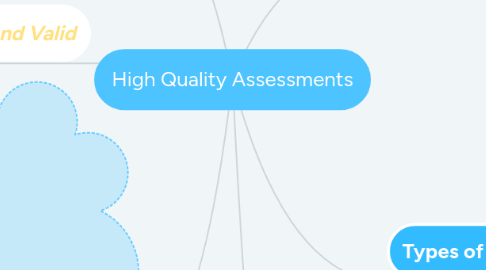
1. Trends in Assessment
1.1. Supplementing objective based tests with alternative assessments.
1.2. Knowledge and skills should not be assessed in isolation.
1.2.1. application of knowledge
1.3. Self-evaluation and evaluation of peers as a form or assessment
1.3.1. I like to use error analysis in solutions and steps.
1.4. Providing specific and applicable feedback during learning not at the "end" of learning.
2. Reliable and Valid
2.1. Validity refers to the "characteristics that refers to the appropriateness of the , uses inferences and consequences that result from the assessment.
2.1.1. Comes from teacher evaluation of the data
2.2. Reliable refers to the extent to which the data is free from error.
3. Alignment
3.1. 1) Understand state standards
3.1.1. unpack the TEKS
3.2. 2) Combine state standards with local learning targets
3.2.1. Using data locally to make decisions on targeted low performing standards.
3.3. 3) Specify cognitive depth, range, and balance
3.4. 4) Align with curriculum and pacing goals
3.4.1. Ensure that appropriate amount of time is spent per needed standard
3.5. 5) Develop classroom assessments
3.5.1. Common Assessments
3.5.2. Vetted resources
3.5.3. Collaboration
3.6. 6) Identify theories of learning and motivation
3.6.1. intrinsic and extrinsic motivation
3.6.2. 7 learning styles
3.7. 7) Instructional strategies
3.7.1. unit lesson
3.7.2. daily lesson
4. Definition: process of collecting data on the attitude, learning, and application of knowledge.
4.1. Why am I doing this assessment?
4.2. How should I gather the data?
4.3. How will I evaluate the results?
4.4. What will I do with the results?
5. Types of Assessments
5.1. Selected response
5.1.1. multiple choice
5.1.2. true/false
5.1.3. matching
5.2. Constructed response
5.2.1. short answer
5.2.2. fill in the blank
5.3. Performance Based
5.3.1. create, produce or do something
5.3.2. extended by creating a product or performance
5.4. Essay
5.4.1. several sentences to paragraphs
5.5. Oral assessments
5.5.1. informal
5.5.2. monitoring learning
5.6. Teacher Observations
5.6.1. verbal and non-verbal
5.7. Student Self-Assessment
5.7.1. self reporting
5.7.2. Answer a questionairree
5.7.2.1. attitudes
5.7.2.2. beliefs
5.7.2.3. effort
6. Positive Consequences
6.1. Students learn to prepare to match your assessments.
6.2. Motivation
6.2.1. Set Goals
6.2.2. Commitment
6.2.3. Continuing commitment
6.3. Motivation increases when it is relevant.
6.4. Feedback increases the teacher-student relationship.
6.4.1. Increases effort and self-efficacy with the content.
6.5. Uses assessments and tasks that are challenging but achievable.
6.6. Emphaize progress
6.6.1. Have students track their own progress linked to effort.

